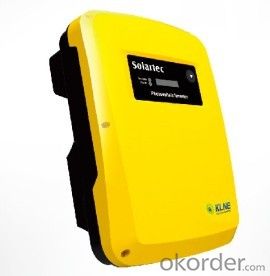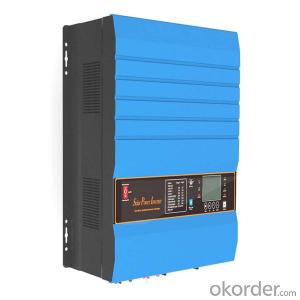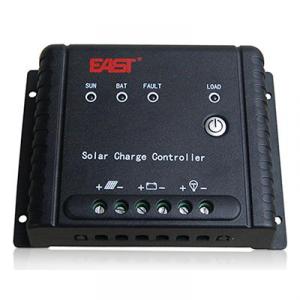Lithium Solar Inverter Solartec 2000 On Grid Inverter with WiFi
- Loading Port:
- Shanghai
- Payment Terms:
- TT OR LC
- Min Order Qty:
- -
- Supply Capability:
- 10000 set/month
OKorder Service Pledge
Quality Product, Order Online Tracking, Timely Delivery
OKorder Financial Service
Credit Rating, Credit Services, Credit Purchasing
You Might Also Like
Solartec 1500,2000,2500,3000,3600,4000,4600,5000
1MPPT, single phase
IP 65
New mold with Pure thick aluminum crust.
Efficient
■ Efficiency of up to 97.6 %
■ TransformerlessSafe
■ Integrated DC switch
■ Comprehensive protection functionsFlexible
■ LCD backlight
■ For indoor and outdoor installationSimple
■ ‘Plug and play’connection for easy installation
■ Friendly interface, easy to install and maintain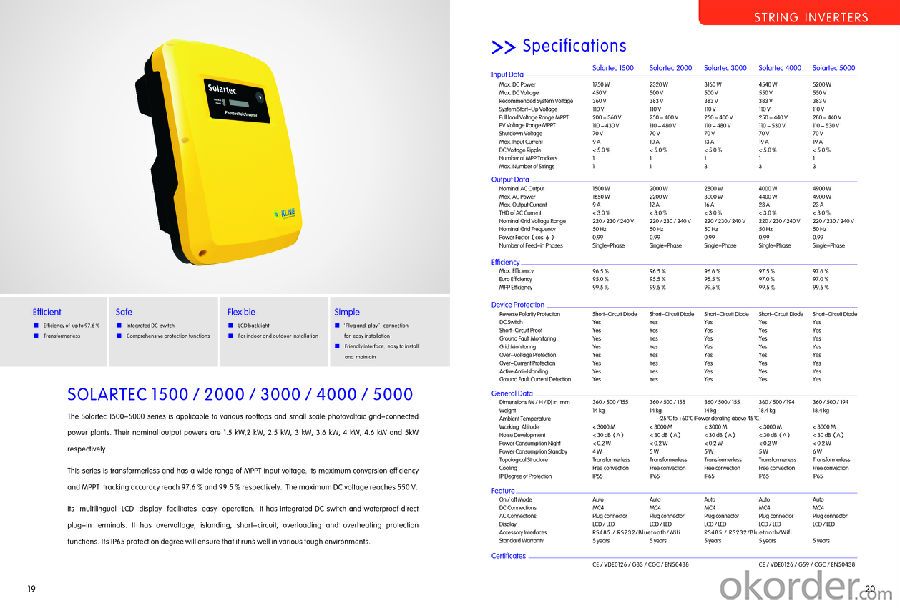
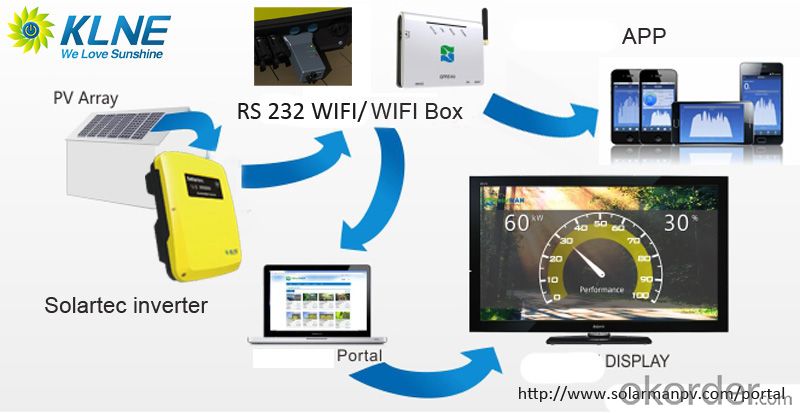
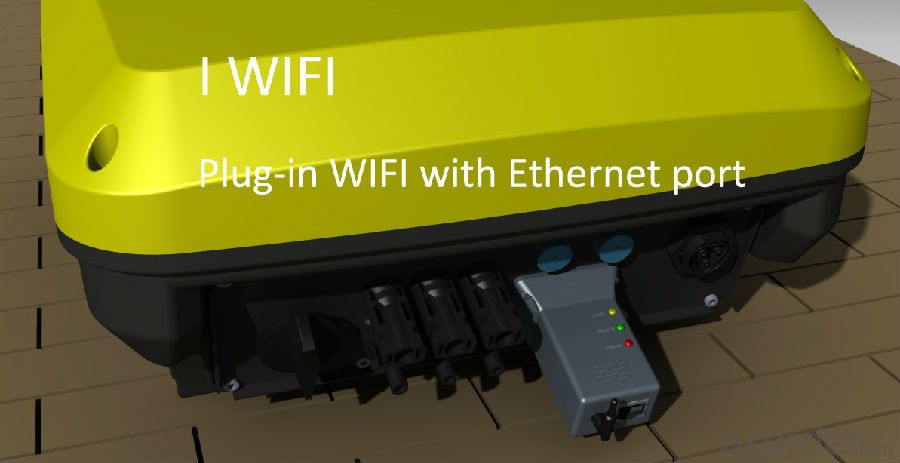
- Q: How is the efficiency of a solar inverter measured?
- The efficiency of a solar inverter is typically measured by dividing the output power of the inverter by the input power, and then multiplying the result by 100 to get a percentage value.
- Q: What is the maximum short-circuit current that a solar inverter can handle?
- The maximum short-circuit current that a solar inverter can handle varies depending on the specific model and design. However, most solar inverters are designed to handle short-circuit currents ranging from 500 Amps to 10,000 Amps, depending on the size and capacity of the inverter.
- Q: Can a solar inverter be used in a hybrid solar system?
- Yes, a solar inverter can be used in a hybrid solar system. A hybrid solar system combines solar power with other sources of energy, such as batteries or a backup generator. The solar inverter is responsible for converting the DC electricity generated by the solar panels into AC electricity that can be used to power appliances and other electrical devices. In a hybrid system, the solar inverter works in conjunction with other components, such as a battery inverter or a grid tie inverter, to manage the flow of electricity between the solar panels, batteries, and the electrical grid.
- Q: Can a solar inverter be used in systems with different module orientations?
- Yes, a solar inverter can be used in systems with different module orientations. Solar inverters are designed to convert the direct current (DC) generated by solar panels into alternating current (AC) for use in homes or businesses. They are compatible with various module orientations, including those that are east-west or south-facing. The inverter's maximum power point tracking (MPPT) technology allows it to optimize energy production regardless of the module orientation, ensuring efficient utilization of solar energy.
- Q: How does the input power rating affect the performance of a solar inverter?
- The input power rating directly affects the performance of a solar inverter. A higher input power rating allows the inverter to handle larger amounts of power generated by the solar panels. This means that a higher input power rating can lead to better efficiency and performance of the solar inverter, as it can convert a greater amount of solar energy into usable electricity. Conversely, a lower input power rating may limit the inverter's capacity to handle high power outputs, potentially resulting in reduced efficiency and performance.
- Q: How does MPPT improve the efficiency of a solar inverter?
- MPPT (Maximum Power Point Tracking) improves the efficiency of a solar inverter by continuously adjusting the operating point of the solar panels to ensure they are producing maximum power. This is achieved by maximizing the voltage and current output of the panels, which allows the inverter to convert more of the available solar energy into usable electricity. By constantly tracking the maximum power point, MPPT ensures that the solar inverter operates at its highest efficiency, resulting in increased overall system efficiency and improved energy generation.
- Q: How does a solar inverter handle voltage and frequency regulation?
- A solar inverter handles voltage and frequency regulation by converting the direct current (DC) generated by solar panels into alternating current (AC) that is suitable for use in homes and businesses. It ensures that the voltage and frequency of the AC output are within the acceptable range set by the grid or electrical appliances. This is achieved through the use of control circuitry and algorithms that continuously monitor and adjust the DC input to maintain a stable and consistent AC output.
- Q: Can a solar inverter be used with a wireless communication system?
- Yes, a solar inverter can be used with a wireless communication system. Many modern solar inverters are equipped with built-in wireless communication capabilities, such as Wi-Fi or Bluetooth, to enable monitoring and control of the solar system remotely. This allows users to access real-time data, adjust settings, and receive notifications about their solar energy production and consumption through a wireless connection.
- Q: How does the maximum AC current rating affect the performance of a solar inverter?
- The maximum AC current rating of a solar inverter determines its capacity to handle and convert the DC power generated by solar panels into usable AC power for the electrical grid. A higher maximum AC current rating allows the inverter to handle larger amounts of power, enabling it to support more solar panels or higher power output. This ensures efficient and uninterrupted performance of the solar inverter, allowing it to meet the energy demands of the system and maximize solar energy production.
- Q: Can a solar inverter be used with energy storage systems?
- Yes, a solar inverter can be used with energy storage systems. In fact, it is a crucial component in connecting solar panels with energy storage batteries. The solar inverter converts the direct current (DC) electricity generated by the solar panels into alternating current (AC) electricity, which can be used to power appliances and charge the energy storage system. Additionally, the inverter also manages the flow of electricity between the solar panels, energy storage system, and the grid, ensuring efficient and reliable power supply.
Send your message to us
Lithium Solar Inverter Solartec 2000 On Grid Inverter with WiFi
- Loading Port:
- Shanghai
- Payment Terms:
- TT OR LC
- Min Order Qty:
- -
- Supply Capability:
- 10000 set/month
OKorder Service Pledge
Quality Product, Order Online Tracking, Timely Delivery
OKorder Financial Service
Credit Rating, Credit Services, Credit Purchasing
Similar products
Hot products
Hot Searches
Related keywords


